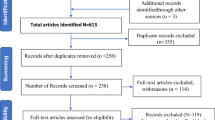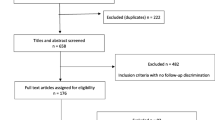Summary
The concentration of methylmethacrylate monomer (MMA) in the blood stream after implantation of the components of 15 total hip prostheses using bone cement was determined in the pulmonary artery, the radial artery, and the superior vena cava after cement application, and correlated with the observed drop in blood pressure and the increase in the pulmonary arterial pressure. In all samples MMA was found. The values ranged from 0.02 μg/ml to 59 gg/ml. The mean maximum value after implantation of the stem was measured to be 7.8μg/ml in the pulmonary artery, 4.6 μg/ml in the radial artery, and 1.75 μg/ml in the superior vena cava. After implantation of the cup the values were clearly lower. The simultaneously recorded blood pressure decreased slightly during the first 3 min and then returned to previous values. The pulmonary arterial mean pressure increased from 18 to 20mmHg during the first 10 min. Although in some patients a drop in blood pressure started at the same time as MMA reached maximum values, high concentrations did not result in a greater effect on the circulatory parameters. Statistical analysis by the Spearman test revealed no correlation between MMA concentrations and the decrease in blood pressure or the increase in the pulmonary arterial pressure.
Zusammenfassung
Während der Implantation von fünfzehn Totalendoprothesen mit Knochenzement wurden die Konzentrationen von Methylmethacrylatmonomer (MMA) in der Arteria pulmonalis, der Arteria radialis and der Vena cava superior bestimmt und mit dem beobachteten Blutdruckabfall and dem Anstieg des pulmonalarteriellen Druckes korreliert. In den Proben konnten MMA-Konzentrationen zwischen 0,02 μg/ml and 59 μg/ml nachgewiesen werden. Die mittlere Maximalkonzentration betrug nach Implantation des Schaftes 7,8 μg/ml in der Pulmonal-, 4,6 μg/ml in der Radialarterie und 1,75 μg/ml in der Vena cava superior. Die Konzentrationen nach Implantation der Pfanne waren deutlich geringer. Der gleichzeitig aufgezeichnete Blutdruck fiel geringgradig während der ersten drei Minuten and kehrte dann auf Ausgangswerte zuriick. Der pulmonalarterielle Mitteldruck stieg von 18 auf 20 mm Hg während der ersten zehn Minuten. Obwohl bei einigen Patienten der Blutdruckabfall mit dem Auftreten maximaler MMA-Konzentrationen zusammenfiel, hatten höhere MMA-Konzentrationen keinen größeren Effekt auf die zirkulatorischen Parameter. Bei der statistischen Analyse mit dem Spearman Test bestand keine statistische Korrelation zwischen den MMA-Konzentrationen und dem Abfall des Blutdruckes bzw. dem Anstieg des pulmonalarteriellen Druckes.
Similar content being viewed by others
References
Breed AL (1974) Experimental production of vascular hypotension, and bone marrow and fat embolism with methylmethacrylate cement. Clin Orthop 102:227–244
Burke DW, Gates EI, Harris WH (1984) Centrifugation as a method of improving tensile and fatigue properties of acrylic bone cement. J Bone Joint Surg [Am] 1265–1273
Charnley J (1970) Acrylic cement in orthopaedic surgery. Churchill Livingstone, Edinburgh
Cohen CA, Smith TC (1971) The intraoperative hazard of acrylic bone cement: report of a case. Anesthesiology 35:547–549
Convery FR, Gunn DR, Hughes JD, Martin WE (1975) The relative safety of polymethylacrylate. J Bone Joint Surg [Am] 57:57–64
Crout DHG, Corkill JA, James ML, Ling RSM (1979) Methylmethacrylate metabolism in man. Clin Orthop 141:90–95
Eggert A, Huland H, Ruhnke J, Seidel H (1974) Der Über-tritt von Methylmethacrylat-Monomer in die Blutbahn des Menschen nach Hüftgelenksersatzoperationen. Chirurg 45:236–242
Engesaeter LB, Strand T, Raugstad TS, Husebo S, Langeland N (1984) Effects of a distal venting hole in the femur during total hip replacement. Arch Orthop Trauma Surg 108:328–331
Fairman PR, Morrow C, Glauser FL (1984) Methylmethacrylate induces pulmonary hypertension and increases lung vascular permeability in sheep. Am Rev Respir Dis 130:92–95
Heinrich H, Kremer P, Winter H, Wörsdorfer O, Ahnefeld FW (1985) Transoesophageale zweidimentionale Echokardiographie bei Hüftendprothesen. Anaesthesist 34:118–123
Homsy CA, Tullos HS, Anderson MS, Diferrante NM, King JW (1972) Some physiological aspects of prosthesis stabilization with acrylic polymer. Clin Orthop 83:317–328
Kim KC, Ritter MA (1972) Hypotension associated with methylmethacrylate in total hip arthroplasties. Clin Orthop 88:154–160
Kallos T, Enis JE, Golland F, Davis J (1974) Intramedullary pressure and pulmonary embolism of femoral medullary contents in dogs during insertion of bone cement and a prosthesis. J Bone Joint Surg [Am] 56:1363–1367
Lipecz J, Nemes C, Baumann F, Csernohorszky V (1974) Circulatory complications during alloarthroplastic operations of the hip joint. Anaesthesist 23:382–388
McLaughlin RE, Di Fazio CA, Hakala M, Abott B, MacPhail JA, Mack WP, Sweet DE (1973) Blood clearance and acute pulmonary toxicity of methylmethacrylate in dogs after simulated arthroplasty and intravenous injection. J Bone Joint Surg [Am] 55:1621–1628
Michelinakis E, Morgan RH, Curtis PJ (1971) Circulatory arrest and bone cement. Br Med J 3:639
Mittelmeier H (1985) Fate of joint implants. Dtsch Arztebl 54:1010–1012
Modig J, Malmberg P (1975) Pulmonary and circulatory reactions during total hip replacement surgery. Acta Anaesthesiol Scand 19:1–19
Modig J, Busch C, Olerud S, Saldeen T, Waernbaum G (1975) Arterial hypotension and hypoxaemia during total hip replacements: the importance of thromboplastic products, fat embolism and acrylic monomers. Acta Anaesthesiol Scand 19:28–43
Peebles DJ, Ellis RH, Stride SDK, Simpson BRJ (1972) Cardiovascular effects of methylmethacrylate cement. Br Med J 1:349–351
Philipps H, Cole PV, Lettin AW (1971) Cardiovascular effects of implanted bone cement. Br Med J 3:460
Powell JN, McGrath PJ, Lahiri SK, Hill P (1970) Cardiac arrest associated with bone cement. Br Med J 3:326
Rinecker H (1980) New clinico-pathophysiological studies on the bone cement implantation syndrome. Arch Orthop Trauma Surg 97:263–274
Rudigier J, Grünert A (1978) Investigations of pathogenesis of reactions in circulation and respiration during the implantation of bone cements. Arch Orthop Trauma Surg 91:85–95
Rudigier J, Ritter G (1983) Pathogenesis of circulatory reactions triggered by nervous reflexes during the implantation of bone cements. Res Exp Med 183:77–94
Rutkow IM, Marlboro PH (1986) Orthopedic operations in the united states, 1979 through 1983. J Bone Joint Surg [Am] 68:716–719
Svartling N, Pfaffli P, Tarkkanen L (1985) Methylmethacrylate blood levels in patients with femoral neck fracture. Arch Orthop Trauma Surg 104:242–246
Tronzo RG, Kallos T, Wyche MQ (1978) Elevation of intramedullary pressure when methylmethacrylate is inserted in total hip arthroplasty. J Bone Joint Surg [Am] 56:714–718
von Issendorff WD, Ritter G (1977) Examinations to establish the intensity and significance of the intramedular pressure during the precipitation of the artificial hip joint. Unfallchirurgie 3:99–104
Wenda K, von Issendorff WD, Rudig L, Rudigier J (1986) The intramedullary pressure during total hip replacement with bone cement. 10th European Congress on Biomaterials, Bologna, Sept. (Abstract)
Wenda K, von Issendorff WD, Rudigier J, Ahlers J (1987) Blood pressure decrease after bone cement — effect of monomer of intramedullary pressure? Proceedings, 13th annual meeting Society for Biomaterials, New York, p 220
Whitenack H, Hausberger FX (1971) Intravasation of fat from the bone marrow cavity. Am J Pathol 65 (2):335–345
Zichner L (1972) Embolien aus dem Knochenmarkkanal als Ursache von Sofort- und Spatkomplikationen nach Einsetzen von intramedullären Femurkopfendoprothesen mit Polymethylmethacrylat. Helv Chir Acta 39:717–720
Author information
Authors and Affiliations
Rights and permissions
About this article
Cite this article
Wendal, K., Scheuermann, H., Weitzel, E. et al. Pharmacokinetics of methylmethacrylate monomer during total hip replacement in man. Arch. Orth. Traum. Surg. 107, 316–321 (1988). https://doi.org/10.1007/BF00451513
Issue Date:
DOI: https://doi.org/10.1007/BF00451513




